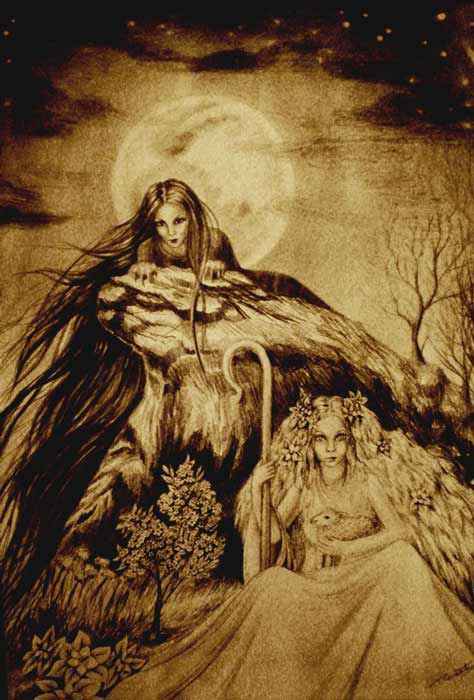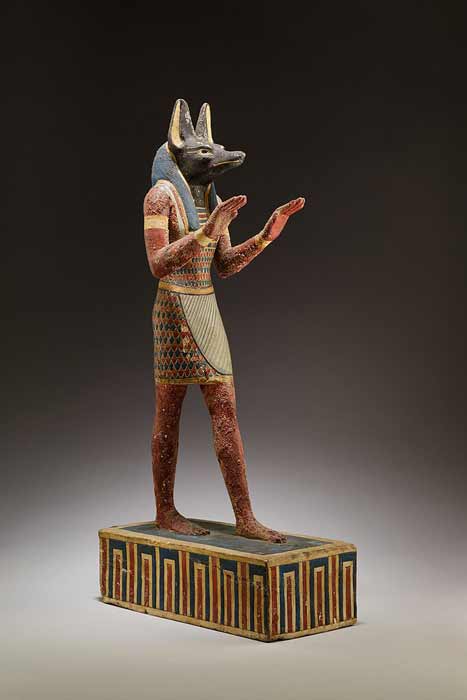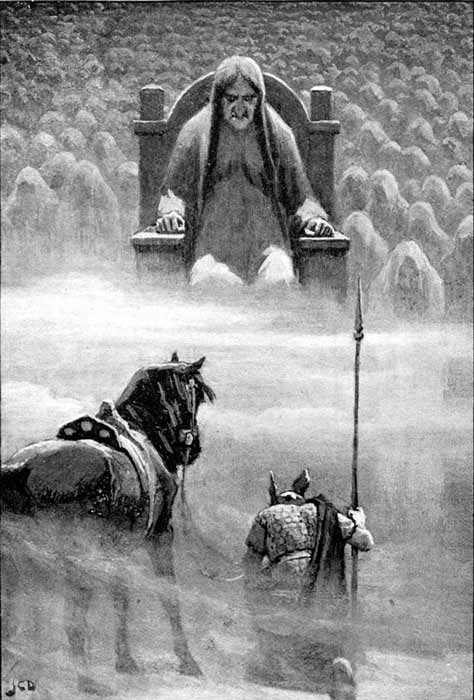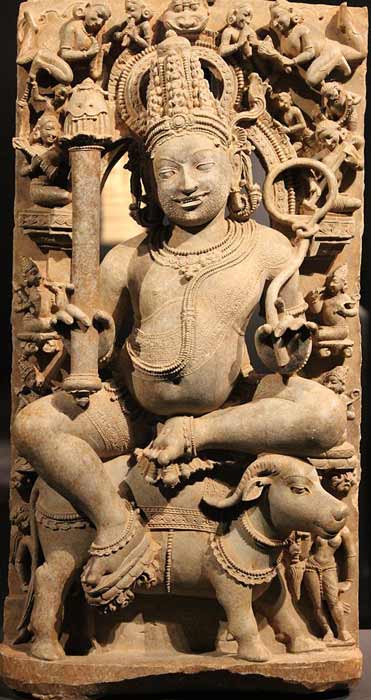
Overlords of the Underworlds: 10 Gods of Death From Around the World
Death always held great significance amongst the ancient cultures of the world. For many, death was a gateway into a new and different life in the underworld that was governed by the gods of death (and the goddesses of death). Life after life wasn’t always considered a dark and gloomy affair: for some it involved joy, feasting, and eternal happiness; while for the others it signified darkness and true death. Today we are discovering some of the fascinating deities of death and the underworld from many varied cultures of our history. And as we understand more about these gods of death, we come to understand that death wasn’t always seen as a bad thing. For some, it was a step into a brave new world.

The Greek god of death Hades with Cerberus his three-headed dog. (Carole Raddato / CC BY-SA 2.0)
1. Hades, the Greek God of Death and his Three-headed Dog
The deities of ancient Greece are well known and there are many. Their classic mythology is extremely diverse and filled with many unique creatures and powerful gods. And the Greek god of death and the underworld is perhaps the best known. Hades, as he is called, is the mighty king of the underworld, presiding over the dead. Always accompanied by his three-headed guard dog, Cerberus, Hades is the brother of two other major Greek Gods: Poseidon and Zeus.
The realm of this god was a misty and glum abode of death, known as Erebus. The dead would enter this realm after crossing the River Styx, ferried across by the boatman Charon. Hades dwelt in this realm and had all power over it and all its inhabitants. He was an immortal god and possessed the gift of invisibility, thanks to the unique “Helm of Darkness” which he wore. In Greek belief, Hades was not fully good nor fully evil. However, the worshippers still feared him, due to his reputation for being stern and rigorously just. He supervised the trial and punishment of the sinful dead, and worshippers often made sacrifices to him to appease him.

Morana & Vesna in a drawing by Ivana Rezek. Morana was the powerful god of death for the ancient Slavs. (Ivana Rezek / CC BY-SA 2.5 SE)
2. Morana, the Death-bringing Winter Goddess of the Slavs
The ancient Slavs had a complex vision of death and the underworld. These two terms were not always synonymous, and how they were viewed could vary from tribe to tribe. Nevertheless, Morana is largely considered as the major Slavic goddess of death. Known also as Marzanna, Marena, and Mara, she was associated with the seasonal changes that brought death and rebirth. In the complex myths and legends of the Slavs, Morana arrives with the winter, which is her realm. And, with winter, death descends on the land. Crops no longer grow, hunger sets in, and life becomes challenging.
Complex rituals were performed towards the winters end, as believers attempted to drive off Morana. It was believed that the winter’s end is the death of this goddess, and the rebirth of Vesna, the goddess of spring. Morana was also considered the goddess of dreams, nightmares, and sorcery, and likened to the ancient Greek goddess Hecate. Today, in most Slavic languages, the words denoting dreams and nightmares have *Mara as their root, coming from the name of this venerated and powerful mistress of winter.

Statuette of Anubis the jackal-headed god of death in ancient Egypt. (Metropolitan Museum of Art / CC0)
3. Anubis, a Jackal-headed Egyptian God to Usher You into the Afterlife
For the ancient Egyptians, death was but a steppingstone to something greater and far more complex than earthly life. When an Egyptian person died, it was believed that their soul would be weighed on special scales. The result of this weighing would decide whether or not they’d enter Duat, the underworld. Anubis was the god connected to death, embalming, the afterlife, and the underworld. He presided over the heart weighing ceremony and ushered the dead into the realm of Duat.
Anubis was depicted with a human body and the head of an Egyptian golden wolf, commonly referred to as a “jackal.” He had a brother, the god Wepwawet, who also had the head of a wolf. For this reason, Ancient Egyptians offered sacrifices to this god, which consisted of mummified jackals. Thousands of these animals were discovered in the burial fields of Saqqara and elsewhere. In the later history of Egypt, Osiris replaced Anubis as the ruler of the underworld, but the latter still had power over the dead, guiding them across the threshold into the realm of death.

This baked clay relief panel is known as the "Burney Relief" or the "Queen of the Night" and it depicts Ereshkigal, the god of death in Mesopotamian mythology. (British Museum / CC0)
4. Ereshkigal, Lady of the Great Place and the Queen of Death
In ancient Mesopotamian mythology, Ereshkigal presided over Kur, the underworld. Known as the “Queen of the Great Earth,” she held the dominion over the dead alongside her husband, the powerful Nergal. Interestingly, Ereshkigal is quite obscure in the surviving cultic texts. On the other hand, she is quite prominently mentioned in the surviving Mesopotamian mythological literature. It is now certain that she held a prominent position in this ancient civilization.
Some sources translate her name as “Lady of the Great Place,” with the great place being the realm of the dead. In the many surviving myths, it is explained that Ereshkigal overtook this realm from her own sister, the major goddess Inanna (Ishtar). Her offspring, messenger and personal servant was Namtar, the evil demon connected with death itself. In Mesopotamia, there was a major temple dedicated to her, situated in the ancient city of Cuthah. It was believed that ceremonies dedicated to her name could cure people and liberate them from evil spirits.

The Slavic god of death Veles as depicted by the artist Marek Hapon. (Mhapon / CC BY-SA 4.0)
5. Veles, The Shepherd of the Souls of the Dead
The ancient Slavs had a much more joyful vision of death and the afterlife than many other contemporary cultures. For them, death signified the forty-day journey to Iriy, a realm best described as heaven. Upon death, it was believed that human souls were transferred into birds that would roost in the branches of a massive linden tree, awaiting the time when they get resurrected once more. The god presiding over these souls was Veles, the shepherd of the dead and the ruler of this underworld.
· The Polabian Slavs: A History of a Vanquished People
· The Wolf Shepherd Deity, Lame Devils And Saints In Slavic Beliefs
Many elements of Veles had an archaic, chthonic connection to the depths of the earth and thus with the underworld. He was associated with dampness, wet places, cattle, hair, and presumably guarded the sacred tree of the underworld from its roots or its base. His role as a guardian of the roosting souls varied from one Slavic tribe to the other, but it is likely that he was just the guardian of the dead, while goddesses such as Roda, or the god Rod would decide which souls were to be reincarnated again. Veles, however, is present amongst all Slavic cultures, which confirms him as one of the oldest Slavic deities.

Hel, the frightening goddess of death who presided over the Viking underworld as depicted by artist John Charles Dollman. (John Charles Dollman / Public domain)
6. Hel, the Frightening Goddess of the Viking Underworld
It is well known that the ancient Vikings had a very unique view of death. Warriors believed that all those who live courageously and die fighting in battle would certainly be welcomed into the halls of Valhalla by their chief god Odin to feast and rejoice. Alas, not all would be granted that privilege. Those who died in some other way would end up in the underworld realm of Nifelheim, where the goddess Hel ruled over the dead.
She is described as a gloomy and despondent woman, whose skin is discolored as in death. In Norse mythology, Hel was always grouped with darker, negative beings. She is said to be a daughter of the trickster god Loki and the giantess Angrboða, the mother of monsters. Her siblings are the terrible wolf Fenrir and the world serpent Jörmungandr. Those that died of sickness, old age, as cowards or as bad persons, were bound to the Halls of Hel, where this goddess would preside over them. Her realm was a stark contrast from the golden halls of Valhalla, and a clear parallel can be seen to the Christian concepts of heaven and hell.

Mictlāntēcutli, the terrible death god of the Aztec underworld. (Katepanomegas / CC BY 3.0)
7. Mictlāntēcutli, the Terrible, Death God of the Aztec Underworld
Death was a major aspect of the ancient Aztec civilization. Therefore, these peoples had many diverse gods and goddesses connected strictly to death and the dead. One god, however, stands out: Mictlāntēcutli. A major Aztec deity, he is the god of death and the ruler of Mictlan, the lowest region of the Aztec underworld. He boasted several names and titles, including Nextepehua, the “Scatterer of Ashes,” Ixpuztec, the “Broken Face,” and Tzontemoc “He Who Lowers His Head.” He was almost always depicted as a pale and ghastly skeleton spattered with blood.
Together with his consort Mictēcacihuātl, Mictlāntēcutli dwelt in a grim house without windows in the darkness of the underworld. The Aztecs commonly associated this god with bats, spiders, owls, and similar nocturnal creatures. He was nevertheless actively worshipped. Ceremonies in the temples of Mictlāntēcutli involved ritual cannibalism and possibly human sacrifice. Those that died were buried with rich grave goods. These served to appease Mictlāntēcutli once the spirit of the dead person finally reached the underworld.

Supay, the demonic dispenser of death in Incan beliefs. (De los Ordoño / CC0)
8. Supay: Demonic Dispenser of Death for the Incas
Enigmatic Supay is a major deity in Quechua, Inca and Aymara myths and beliefs. This demonic being was the god of death and the overlord of the Incan underworld, which was known as Uchu Pacha. Presiding over the deceased as well over a race of cruel demons, Supay was envisioned as a demonic entity with a grim face and twisting malignant horns. It was known that the Inca greatly feared this god of death and the underworld and worshipped him and sacrificed to him to stay safe from his harmful ways.
Due to these negative aspects and the fear he instilled in the worshippers, Supay was quickly connected to the concept of the Christian devil, following the Spanish colonization of the Americas. In fact, over the centuries, the name “Supay” was the local word used for the Christian devil. However, in pre-Christian times, the indigenous peoples performed many elaborate and evocative dances and rituals dedicated to the god Supay.

The Roman god of death Orcus and his immense mouth that leads to the other side, in the park of monsters near Bomarzo, Italy. (Alessio Damato / CC BY-SA 3.0)
9. Orcus, the Tormentor of the Dead and an Old Etruscan God
The Italic, pre-Roman mythology of the Apennine Peninsula is still somewhat clouded in mystery. Still, as the Romans rose to power and prominence, their mythology and pantheon showed a slight glimpse into the beliefs of the cultures that preceded them. Orcus, the god of the underworld in Roman mythology, was also present amongst the Etruscans and some Italic tribes. Orcus was the ruler of the Roman Hades, their underworld, and punished evildoers and those who broke their oaths.
In certain tomb paintings, Orcus is depicted as a hairy, bearded giant that torments sinners in the afterlife, eternally. Some scholars suggest that Orcus is derived from the Ancient Greek demon Horkos, and that proof of this can be seen in the similar names. The cult of Orcus was dominant in the Italian countryside, which allowed this deity to survive all the way to the Middle Ages. Still, his image and role was greatly transformed, and his original role forgotten.

Yama, the venerable Hindu god of death, is depicted in this ancient rock sculpture in India. (Nomu420 / CC BY-SA 3.0)
10. Yama, the Venerable Hindu Death God
Both the Hindu and Buddhist religions are filled with diverse and often dark and morbid deities. Yama, known also as Yamarāja, is their god of death and the underworld and also one of the oldest and most important deities in their worldviews. The mythology tells us that Yama is the son of the great Sun god Surya, and the very first human being to have died. Because of this, he became the ruler of the dead, presiding over the underworld as the lord of the spirits of the deceased.
- Worshipped by Millions: The Sacred River Ganges
- Polytheistic Religion: How Pantheons Reigned in the Ancient World
Yama is a just and righteous god, and stern to boot. In the underworld, he dispenses justice and punishment to the sinners in his realm. In most depictions, Yama is shown as a blue or dark-complexioned man astride a buffalo. In his arms he carries a noose and a mace: the tools he uses for capturing the souls of the dead. To this day, he remains one of the oldest Hindu gods.
The Mysteries Beyond the Light in the Tunnel
In the history of mankind, death is the oldest ever-present phenomena. In the early civilizations and human cultures, death was often difficult to understand because people had little knowledge of the intricacies of the human body. For millennia, people believed in souls and their life after death, as they still do. The gods and goddesses of death and the underworld were thus a logical creation, a way to give meaning to a concept they could not explain. And just as death is dark, tragic, and ugly, so were these deities frightening and nightmarish in their appearance.
Top image: Anubis, the god of death in ancient Egypt, is a jackal-like creature with immense powers. The hieroglyph for Anubis is shown in the center. Source: MiaStendal / Adobe Stock
By Aleksa Vučković
References
Abel, E. 2009. Death Gods: An Encyclopedia of the Rulers, Evil Spirits, and Geographies of the Dead. ABC Clio.
Dart, H. 2016. Gods of Death: An Encyclopedia of Death Deities. CreateSpace Independent Publishing Platform.
Roberts, M. E. 2020. Underworld Gods in Ancient Greek Religion: Death and Reciprocity. Taylor & Francis.















